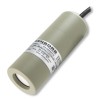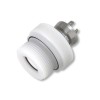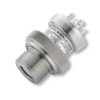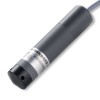Durable hydrostatic liquid level and pressure sensors designed for harsh chemical environments. Ideal for storage tanks and process applications requiring high corrosion resistance.
This range of chemical-resistant hydrostatic liquid level and pressure sensors is specifically engineered for reliable measurement in environments containing aggressive or caustic media where standard metallic sensors would rapidly corrode and fail. Featuring robust plastic housings made from materials like PVDF, PVC, or PP, and advanced semi-flush ceramic diaphragms, these instruments offer exceptional compatibility with a wide array of corrosive chemicals. Designed for engineers and technicians in chemical processing, storage, wastewater treatment, and research, these sensors ensure accurate and durable performance for critical hydrostatic level monitoring in tanks or direct process pressure measurement, preventing mechanical failure and maintaining operational safety.
 Viscous machine tool coolant level measurement with flush diaphragm sensor - Using a flush ceramic diaphragm to prevent clogging in viscous machine tool coolant tanks, ensuring reliable level measurement for oil and water emulsions containing swarf.
Viscous machine tool coolant level measurement with flush diaphragm sensor - Using a flush ceramic diaphragm to prevent clogging in viscous machine tool coolant tanks, ensuring reliable level measurement for oil and water emulsions containing swarf. Chemical resistant level sensor for sodium hydroxide and bleach - Plastic-bodied submersible transmitter with a flush ceramic sensor provides reliable level measurement in a disinfection tank containing high-density, aggressive media.
Chemical resistant level sensor for sodium hydroxide and bleach - Plastic-bodied submersible transmitter with a flush ceramic sensor provides reliable level measurement in a disinfection tank containing high-density, aggressive media.
 LMK351 High Overpressure Flush Level Transmitter
LMK351 High Overpressure Flush Level Transmitter LMK809 Plastic Submersible Low Level Transmitter
LMK809 Plastic Submersible Low Level Transmitter DMK 331 Ceramic Diaphragm Industrial Pressure Transmitter
DMK 331 Ceramic Diaphragm Industrial Pressure Transmitter LMK331 Screw-In Ceramic Level Transmitter
LMK331 Screw-In Ceramic Level Transmitter
- Oilfield chemical injection system remote wireless pressure monitor - Wireless pressure sensing system with cellular data transmission for monitoring chemical injection manifolds on remote oilfield wells.
- Remote monitoring of natural gas pressure in large commercial buildings - Discover how wireless pressure transducers and an IoT gateway provided a cost-effective solution for remotely monitoring natural gas pressure to high-level radiant heaters in a large arena, eliminating the need for costly wiring and manual data collection.
- HVO and FAME biofuel storage tank submersible level sensor - Explore a solution for reliably measuring the level of biodiesel fuels such as HVO and FAME. A submersible level transmitter was specified with carefully selected wetted parts, including an FEP cable and FKM seals, to ensure long-term chemical compatibility in alternative fuel storage tanks.
- High sulphuric acid content resistant 16 bar g 4-20mA water pressure sensor - This 4-20mA pressure sensor with PVDF, ceramic, and FKM construction is designed for water with high sulfuric acid content up to 10%. Ideal for chemical processing and wastewater treatment.
- Hydrochloric acid storage tank 1mH2Og hydro-static pressure transmitter - A hydro-static pressure transmitter for storage tank level monitoring use to measure level of 36% hydrochloric acid over a range of 0 to 1 mH2O g by immersion in the tank, and sending the corresponding 4-20mA signal through the submersible electrical connection.
- Trichloroethylene compatible 100 mbar Ex pressure transmitter - Intrinsically safe pressure transmitter with ceramic diaphragm for trichloroethylene compatibility. Ideal for low-pressure measurement in hazardous areas.
 LMK807 Plastic Submersible Level Transmitter
LMK807 Plastic Submersible Level Transmitter LMK 806 Plastic 21mm diameter Submersible Level Probe
LMK 806 Plastic 21mm diameter Submersible Level Probe LMK 858 Plastic Submersible Liquid Level Sensor with Removable Cable
LMK 858 Plastic Submersible Liquid Level Sensor with Removable Cable
- Chlorine dioxide (ClO2) resistant 20 bar PVDF pressure sensor - The dmk331 pressure transmitter offers reliable pressure measurement in chlorine dioxide applications up to 20 bar. Features PVDF, ceramic diaphragm, and FKM seals wetted parts for enhanced chemical resistance.
 Plastic Submersible Hydrostatic Liquid Level Sensors - Explore our selection of corrosion-resistant submersible hydrostatic level sensors specifically designed for challenging chemical applications
Plastic Submersible Hydrostatic Liquid Level Sensors - Explore our selection of corrosion-resistant submersible hydrostatic level sensors specifically designed for challenging chemical applications Plastic Externally Fitted Hydrostatic Liquid Level Sensors - Plastic externally fitted hydrostatic level sensors with ceramic diaphragms offer a reliable and cost-effective solution for measuring liquid levels in chemical storage tanks.
Plastic Externally Fitted Hydrostatic Liquid Level Sensors - Plastic externally fitted hydrostatic level sensors with ceramic diaphragms offer a reliable and cost-effective solution for measuring liquid levels in chemical storage tanks. Corrosive Chemical Compatible Flush Diaphragm Liquid Level Sensors - These sensors are designed to withstand aggressive chemicals while providing accurate and stable level readings, ensuring process integrity and preventing contamination.
Corrosive Chemical Compatible Flush Diaphragm Liquid Level Sensors - These sensors are designed to withstand aggressive chemicals while providing accurate and stable level readings, ensuring process integrity and preventing contamination.
Find out more about Chemical Resistant Hydrostatic Liquid Level & Pressure Sensors to determine which product options and capabilities will best meet your application requirements.
When measuring hydrostatic liquid level or process pressures in applications involving aggressive or caustic chemicals, the material integrity of the sensing element and its housing is paramount. Standard metallic pressure transmitters and transducers are often susceptible to rapid chemical corrosion, particularly affecting thin metal diaphragms which can be quickly eroded, leading to premature sensor failure and potential safety hazards. For instance, common industrial chemicals like concentrated sulfuric acid, sodium hypochlorite, or hydrofluoric acid can degrade even robust metals like stainless steel over time, necessitating specialized sensor designs.
To address these challenging environments, pressure sensors constructed from chemically inert materials are essential. These often feature robust plastic-based bodies and advanced ceramic diaphragms. Ceramic, typically high-purity alumina oxide (Al2O3), is selected for its exceptional resistance to a wide spectrum of aggressive chemicals, including strong acids, alkalis, and solvents, even at elevated process temperatures. Unlike metals, ceramic does not rely on a passive oxide layer for protection, making it inherently more stable in diverse chemical matrices. The inert nature of ceramic also prevents leaching or contamination, which is critical in high-purity applications such as pharmaceutical manufacturing or semiconductor fabrication.
A key design feature in many chemical-resistant pressure sensors is the semi-flush ceramic sensing diaphragm. This configuration minimizes cavities or dead volumes at the sensing face, preventing the accumulation, crystallization, or solidification of viscous or particulate-laden media. This is particularly beneficial in applications like wastewater treatment facilities handling sludges, or in chemical processing plants where product build-up could lead to inaccurate readings or blockages. The semi-flush design also facilitates easier and more effective cleaning, crucial for maintaining measurement accuracy and extending sensor lifespan in batch processes or when switching between different media.
The selection of sensor housing material is equally critical and must be carefully matched to the specific chemical composition, concentration, and operating temperature. Common housing materials include PVDF (Polyvinylidene Fluoride), known for its outstanding resistance to halogens, strong acids, and organic solvents, making it suitable for demanding applications such as bulk chemical storage tank level monitoring for chemicals like bromine or concentrated nitric acid. PVC (Polyvinyl Chloride) offers a cost-effective solution with good resistance for many common industrial chemicals like ferric chloride used in water treatment. PP (Polypropylene) provides a balance of chemical compatibility and mechanical strength, often used in chemical dosing systems or plating baths. While plastic housings are prevalent, some designs may incorporate stainless steel for the external body to provide enhanced mechanical protection, especially in harsh industrial settings, with the wetted parts still being composed of the necessary corrosion-resistant plastics and ceramics.
The principle of hydrostatic level measurement (P=ρgh) relies on the pressure sensor being submerged or connected to the lowest point of a tank. The sensor measures the pressure exerted by the liquid column, which is directly proportional to the liquid level. In such direct immersion scenarios, not only the diaphragm and housing but also the cable sheath material (if applicable) must withstand prolonged chemical exposure. For example, in a sump containing a mixture of unknown industrial effluents, a sensor with broad chemical resistance is vital for reliable level monitoring and overflow prevention. Similarly, for process pressure measurement within reactors or pipelines carrying corrosive fluids, such as in fertilizer production or metal etching processes, the chemical inertness of these specialized sensors ensures accurate process control and system integrity.
